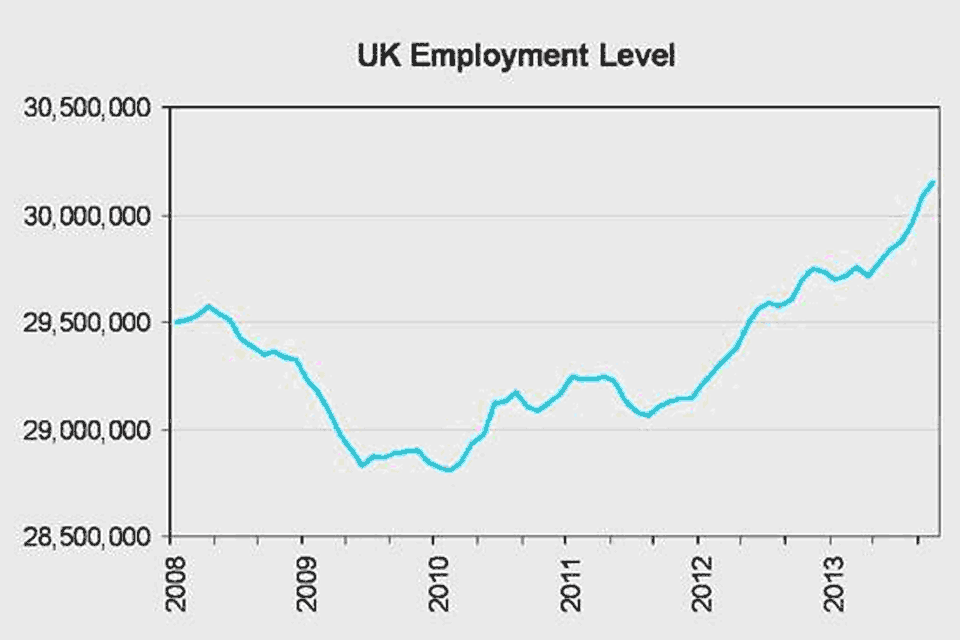Largest quarterly rise in employment since records began
The number of people in a job rose 280,000 in the last 3 months – the largest quarterly increase since records began.

The number of people in a job rose 280,000 in the last 3 months – the largest quarterly increase since records began – according to figures published by the Office for National Statistics this morning (22 January 2014).
There are now a record-breaking 30.15 million people in work – an increase of 1.3 million since 2010. Creating jobs and getting people into employment are central to the government’s long-term economic plan to build a stronger, more competitive economy, so hardworking people can secure their future.

Unemployment also fell 167,000 in the last 3 months, which is the largest quarterly fall since August to October 1997. The unemployment rate now stands at 7.1%. There are also nearly 250,000 fewer people claiming Jobseeker’s Allowance than in 2010.

Employment Minister Esther McVey said:
Creating jobs and getting people into employment are central to our economic plan to build a stronger, more competitive economy, so it is very encouraging news that we’ve seen a record-breaking rise in employment over the last 3 months – the largest ever.
With the highest quarterly fall in unemployment since 1997, it’s clear that the government’s long-term economic plan to get people off benefits and into work so they can secure their future is proving successful.
Esther McVey talks about the latest employment figures
The number of young people in work also increased by 77,000 in the last 3 months. Youth unemployment fell 39,000 in the same period and the number of young people claiming Jobseeker’s Allowance fell for the 19th month running.
Today’s figures also show:
- full-time employment rose 220,000 on the quarter and part-time employment rose 59,000 – the number of part-time workers who could not find full-time employment fell this month by 12,000
- the number of people unemployed for more than a year fell 61,000 in the last 3 months
- the number of people claiming JSA fell 24,000 on the month – the 14th consecutive monthly fall – there are now nearly 250,000 fewer people claiming JSA than in 2010
- there were nearly 570,000 job vacancies between October to December 2013, an increase of 75,000 from a year earlier
Background to labour market statistics: January 2014
This month’s Labour Force Survey covers September to November 2013. The claimant count is for December 2013 and the vacancy count for October to December 2013.
- 30.15 million people were in work in September to November 2013
- the employment level rose 280,000 on the previous quarter and 450,000 on the year
- the employment rate is 72.1%, up 0.5 points on the quarter and up 0.7 points on the year
ILO unemployment fell this quarter
- 2.32 million people were ILO unemployed in September to November 2013, down 167,000 on the previous quarter and 172,000 on the year
- the ILO unemployment rate is 7.1%, down 0.5 points on the quarter and down 0.6 points on the year
The level of economic inactivity is down on the quarter and on the year
- the economic inactivity level is 8.93 million in September to November 2013, down 22,000 on the previous quarter and 75,000 on the year
- the economic inactivity rate is 22.2%, down 0.1 points on the quarter and down 0.2 points on the year
- excluding students, inactivity as a share of the 16-64 population is 16.5%, unchanged on the quarter and down 0.4 points on the year
The number of people on JSA fell this month, and the number claiming one of the other main out-of-work benefits is also improving
- claimant unemployment was 1.25 million in December 2013, down 24,000 on the month and down 307,000 on the year
- the claimant count rate is 3.7%, down 0.1 points on the month and down 0.9 points on the year
- in the year to May 2013, the number claiming incapacity benefits fell 71,600 to 2.46 million. The most recent provisional figure for October 2013 suggests the caseload is at about the same level
- in the year to May 2013, the number of lone parents on income support fell 77,400 to 500,000. The provisional figure for October 2013 is 490,000
The number of redundancies fell and unfilled vacancies rose on the quarter
- there were 112,000 redundancies in September to November 2013, down 21,000 on the previous quarter and 47,000 on the year
- ONS’ vacancy survey estimates an average of 569,000 unfilled vacancies in the three months to December 2013, up 22,000 on the previous quarter and 75,000 on the year
Total weekly pay in November 2013 was up by 0.9% over the year
- growth in regular weekly pay, excluding bonuses, was up by 0.9% on the year
Contact Press Office
Media enquiries for this press release – 0203 267 5161
Press Office
Caxton House
Tothill Street
London
SW1H 9NA
Telephone: 0115 965 8781
Follow DWP on:
- Twitter – www.twitter.com/dwppressoffice
- Facebook – www.facebook.com/dwp
- LinkedIn – www.linkedin.com/company/dwp
- YouTube – www.youtube.com/dwp